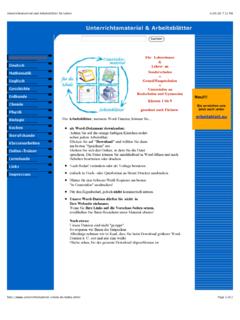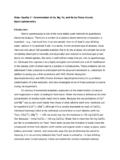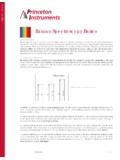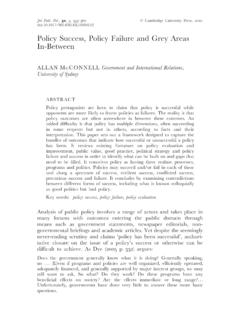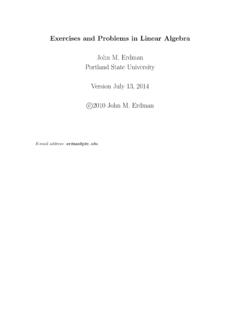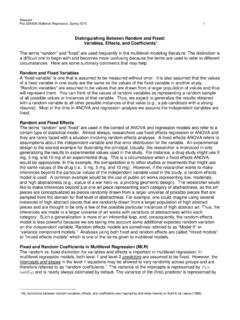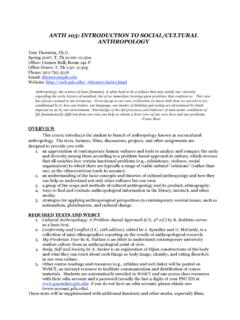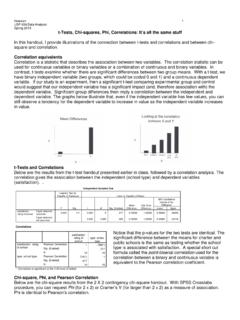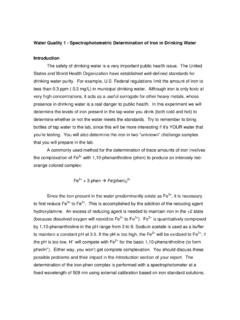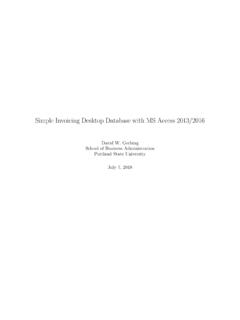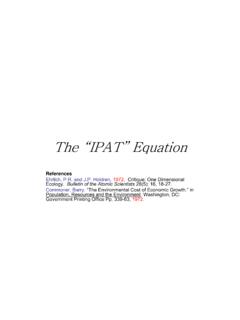Transcription of Centering in Multilevel Regression - Portland State University
1 Newsom Psy 526/6126 Multilevel Regression , Spring 2019 1 Centering in Multilevel Regression Centering is the rescaling of predictors by subtracting the mean. In OLS Regression , rescaling using a linear transformation of a predictor ( , subtracting one value from every individual score) has no effect on the significance tests and does not alter the standardized slope values (interpretation of the metric of the unstandardized slope may differ with these linear transformations, but in an understandable way). The effects of Centering on Multilevel Regression are quite complex and deserve more consideration than is possible here, but I would like to make a few general points. Intercept Interpretation With Multilevel Regression , however, intercepts and intercept variances are of interest and linear transformations impact these values as well as their significance tests.
2 One can see in the formula for the intercept at level one (or similarly in OLS Regression ) that the intercept depends on the value of X at its mean. 01jjjjYX = If we recompute the predictor by subtracting the mean from every score (ijijjxXX= ), the value of the intercept will change. The intercept is no longer the expected value of Y when X equals the original zero value but, instead, when the value when X is equal to its original mean. Because the 00 is the average of all of the 0j values, its value and interpretation also is affected by Centering . There are two different versions of Centering in Multilevel Regression , grand mean Centering and group mean Centering (sometimes called " Centering within context"). Grand mean Centering subtracts the grand mean of the predictor using the mean from the full sample (X). Group mean Centering subtracts the individual's group mean (jX) from the individual's score.
3 Generally, Centering makes this value more interpretable, because the expected value of Y when x (centered X) is zero represents the expected value of Y when X is at its mean. In many cases, such as when age is a predictor, the interpretation of the intercept will be unreasonable or undesirable ( , value of the outcome when age equals zero) without some type of Centering . It thus appears that raw, uncentered predictors should not be the researcher's default scaling. Effects of Centering on Intercept Variance Not only is the average intercept impacted by Centering , but the variance of the intercepts is affected by Centering as well. The direction of the effect of Centering and the degree of effect depends on the pattern of within-group slopes. The picture below illustrates that moving the location of the Y-axis by rescaling X, would lead to a different estimate of the variance of the group intercepts in this case.
4 One can imagine then how the covariance among slopes and intercepts will be affected too. Newsom Psy 526/6126 Multilevel Regression , Spring 2019 2 Reintroduced means One special case of a level-2 predictor is a variable that has been computed by averaging the responses for all cases in each group, thereby creating a group-level variable with one value for each group. An example might be calculating the average of the individual student SES values for each classroom and then using these averages as a level-2 predictor in a Multilevel Regression . When a group-mean centered level-1 predictor and this special type of level-2 variable is used in the model together, it is sometimes referred to as "reintroducing the mean" of the predictor, because the group mean was removed when the level-1 predictor was group-mean centered. Often the motivation for this type of model is to investigate separate within-group and between-group effects of the predictor.
5 For example, what is the impact of individual-level SES on math achievement as compared with the effect of school-level SES? In this special type of model, when the level-1 and level-2 counterparts are included as predictors, Centering approaches can impact the interpretation of the coefficient (Raudenbush & Bryk, 2002, Table , p. 140, and Snijders & Bosker, 2012, Section , provide good explanations). If group-mean Centering of the level-1 predictor is used, the level-1 predictor coefficient, 10, will represent the with in-group effect and the level-2 predictor, 01, will represent the between-group effect. In the case of grand-mean Centering , however, 10 and 01 are estimates of the within-group effect and the compositional effect (difference between the within and between slopes), respectively. The compositional effect coefficient can be derived from the between- and within-group coefficients in the group-mean centered model.
6 The compositional effect may be of interest in some cases, but I suspect that researchers are more often interested in estimating the within-group and between-group effects in order to obtain the independent micro and macro level contributions of a certain predictor. Recommendations The primary decisions about Centering have to do with the scaling of level-1 variables. Because there is only one score per group, however, there is only one choice for Centering of level-2 variables grand mean Centering . Thus, the decision is simple for level-2 variables. In most cases, researchers would likely choose to grand mean center level-2 variables to improve the interpretation of the intercept values. Of course, one should not blindly follow this recommendation, but there will be far more instances where Centering the predictor makes more sense than not Centering the predictor.
7 Interpreting the intercept as the value when the level-2 predictor is equal to zero may be desirable in some cases, but I venture to guess not in most cases. Choices made regarding Centering level-1 variables are much more difficult. Generally, in most if not nearly all circumstances, intercept interpretation will be more reasonable using some type of centered predictors as compared with using uncentered predictors. The consequences of choosing grand- or group-mean Centering are almost overwhelming and I cannot make any global recommendations. The best I can do is urge a careful reading of the most thorough considerations of this topic (Algina & Swaminathan, 2011; Enders & Tofighi, 2007), but I provide a summary of some of the general conclusions from these sources in the table below. At this point in the course we are considering group-nested designs only, but we will revisit the issue in the context of longitudinal (growth curve) models.
8 Wang and Maxwell (2015) is a source that discusses Centering specifically in the longitudinal case. Newsom Psy 526/6126 Multilevel Regression , Spring 2019 3 Raw uncentered variables Grand mean Centering Group-mean Centering Rarely makes sense unless there is a desire to estimate intercept and intercept variance when the predictor is equal to zero ( , mean or variance of group means for females only). Does not make sense when X = 0 is an unreasonable or undesirable value ( , age = 0) Entails assumption that group means are uncorrelated with the predictor (Algina & Swaminathan, 2011). Effect of level-2 controlling for level-1 variables. If adjusted group mean is desired interpretation of average intercept, and variance of adjusted group means is desired interpretation of intercept variance. Interactions between level-2 variables. (Interaction estimate and test are unaffected, but lower order terms are).
9 Entails assumption that group means are uncorrelated with predictor. Inclusion of level-2 variables in a model without level-1 reintroduced mean variables will not fully control for the covariate. Use if pure level-1 effect is desired without considering level-2 variables. Group-mean centered variables will be uncorrelated with level-2 variables and therefore estimates of the effect of the level-1 variable will not partial out level-2 variables. When accurate slope variance estimates are desired When relative between and within effects of the same construct at level 1 and level 2 is desired ( , SES and average class SES). If effects of level-2 variables only of interest without regard to partialling level-1 variables out. When cross-level interactions are of interest and interpretation of "main effect" is of interest. Inclusion of level-2 variables in a model without level-1 reintroduced mean variables will not fully control for the covariate.
10 Cross-level interactions. Cross-level interaction coefficients are relatively unaffected by Centering decisions, although Algina and Swaminathan point out that this assumes no other covariates have confounding interactions with the independent variables. Lower order terms ("main effects" of the predictors involved in the interaction) are affected by Centering , however. Bauer and Curran (2005) recommend group-mean Centering level-1 predictors (and grand-mean Centering level-2) to improve computation and interpretation of the "main effects" when cross-level interactions are tested. Centering dichotomous predictors? It may seem odd to center a dichotomous predictor like gender, but if original coding of 0,1 is used, then the intercept and variance of the intercept represents the mean of the 0 group and the variance of the zero group. There is nothing incorrect about this, but it may not be desirable to simply estimate the variance of the intercepts for the 0 group in many cases.
